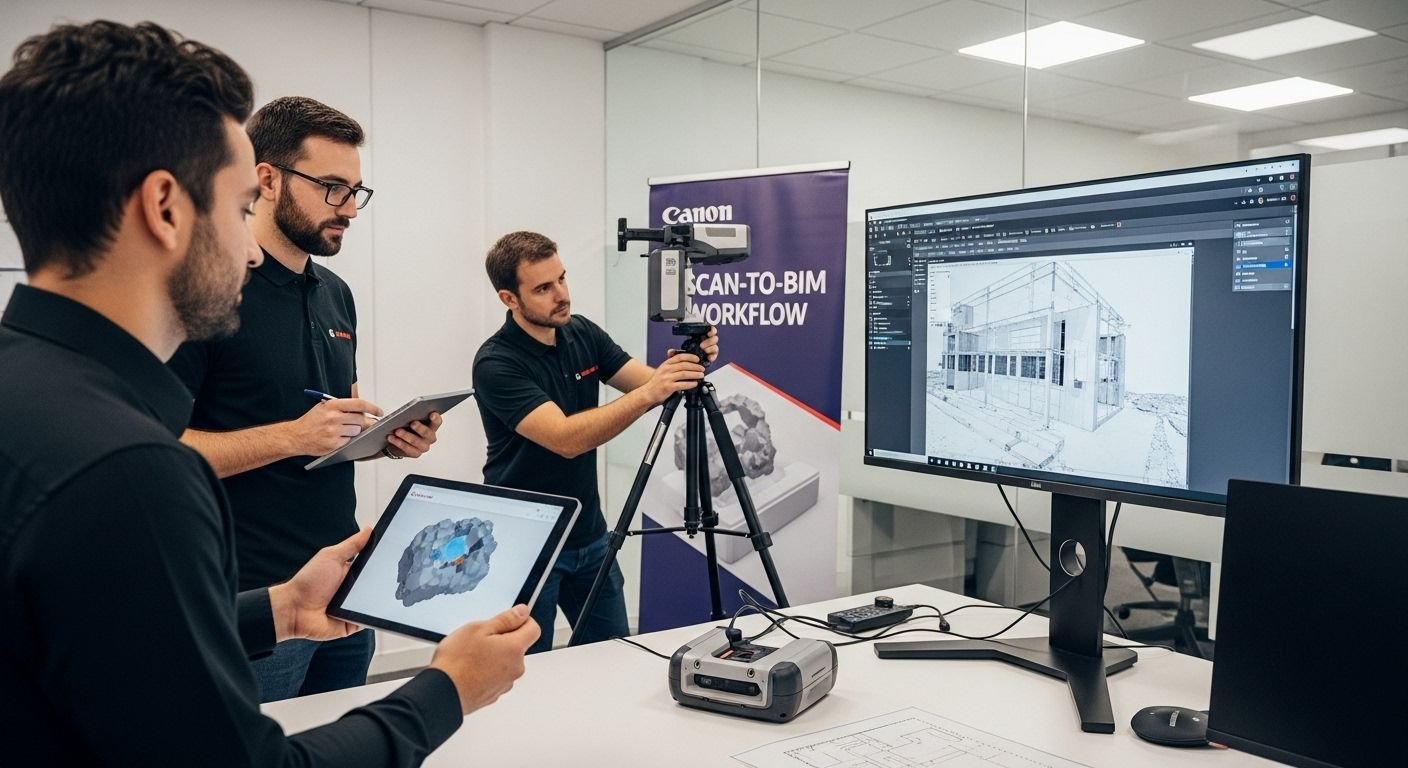BIM coordination rewrites the rules of construction by enabling every discipline to work from the same advanced digital blueprint. Most teams still assume that clashes on-site are inevitable, but up to 80 percent of construction errors can be avoided through proper BIM coordination and clash detection. The real surprise is how this process not only cuts errors but unlocks a new level of collaboration and precision you might not expect from traditional building workflows.
Table of Contents
- Understand The Importance Of BIM Coordination
- Gather Required Team Members And Stakeholders
- Establish Clear Communication Protocols
- Define Project Goals And Expectations
- Create A Comprehensive BIM Execution Plan
- Regularly Update The BIM Model
- Conduct Clash Detection Analyses
- Review And Revise The Coordination Checklist
Quick Summary
| Minimise conflicts with BIM coordination | Use integrated digital models to identify design clashes before construction begins, reducing errors and rework. |
| Assemble a diverse project team | Gather stakeholders from various disciplines to enhance communication and collaboration throughout the project. |
| Establish clear communication protocols | Create structured guidelines for information exchange to ensure team members understand their roles and project expectations. |
| Define specific project goals | Set measurable objectives for BIM implementation to guide decisions and actions effectively throughout the project lifecycle. |
| Regularly update the BIM model | Maintain model accuracy by establishing consistent update schedules and clear version control to reflect real-time project changes. |
1: Understand the Importance of BIM Coordination
Building Information Modelling (BIM) coordination represents a transformative approach to construction management that goes far beyond traditional drafting techniques. At its core, BIM coordination is about creating an integrated digital representation of a project that allows unprecedented collaboration and precision.
The primary goal of BIM coordination is to minimise potential conflicts and errors before physical construction begins. By creating a comprehensive 3D digital model that incorporates architectural, structural, mechanical, electrical, and plumbing systems, professionals can identify and resolve potential design clashes virtually.
According to the National Institute of Building Sciences, BIM coordination ensures the efficiency and harmony of facility elements, reducing design errors through sophisticated clash detection techniques. Key benefits include:
- Identifying spatial conflicts between building systems before construction
- Reducing expensive rework and project delays
- Improving communication across multidisciplinary project teams
- Enhancing overall project visualization and understanding
Professional BIM coordinators utilise advanced software tools to perform intricate geometric and system-level analyses. This process involves meticulously examining potential intersections between different building components, such as:
- Structural steel elements
- Mechanical ductwork
- Electrical conduits
- Plumbing pipework
By addressing these potential conflicts digitally, construction teams can significantly reduce costly on-site modifications and streamline the entire building process. The result is a more efficient, accurate, and cost-effective project delivery that minimises risks and maximises collaboration.
2: Gather Required Team Members and Stakeholders
Successful BIM coordination requires a strategic approach to team assembly, where collaboration and clear communication become paramount. The process of gathering team members is not simply about collecting individuals but creating a synergistic group capable of transforming project complexity into streamlined execution.
According to the BIM Project Execution Planning Guide, assembling a comprehensive planning team involves identifying representatives from key project domains. The core team typically includes professionals representing diverse yet interconnected disciplines.
Critical stakeholders for effective BIM coordination typically encompass:
- Project owner or client
- Lead architect
- Structural engineer
- Mechanical engineering specialist
- Electrical engineering professional
- Plumbing systems expert
- Construction manager
- Cost estimator
- Facilities management representative
Each team member brings unique perspectives and technical expertise that contribute to a holistic project understanding. The goal is not merely participation but active, meaningful engagement. This means establishing clear communication protocols, defining individual responsibilities, and creating a collaborative environment where knowledge sharing becomes second nature.
Key considerations when assembling your BIM coordination team include:
- Ensuring technical competency in BIM software and processes
- Establishing clear lines of communication and reporting
- Defining individual roles and interdependencies
- Creating a culture of mutual respect and open dialogue
By carefully selecting and integrating team members who understand both their specific domain and the broader project context, organisations can significantly enhance project outcomes, reduce potential conflicts, and drive more efficient construction processes.
3: Establish Clear Communication Protocols
Effective BIM coordination hinges on robust communication frameworks that transcend traditional project management approaches. Establishing clear communication protocols transforms fragmented interactions into a seamless, collaborative ecosystem where information flows transparently and efficiently.
According to a systematic review on BIM implementation, standardised communication guidelines are critical for successful multidisciplinary team collaboration. These protocols serve as the backbone of information exchange, ensuring that every team member understands their role, responsibilities, and communication expectations.
Critical elements of effective communication protocols include:
- Defining primary communication channels
- Establishing response time expectations
- Creating standardised document naming conventions
- Implementing regular status update schedules
- Selecting appropriate collaborative digital platforms
The communication strategy must address both formal reporting mechanisms and informal knowledge sharing. This means creating structured pathways for official project updates while simultaneously fostering an environment that encourages spontaneous, constructive dialogue.
Key considerations when developing communication protocols encompass:
- Determining frequency of team meetings
- Specifying preferred communication tools
- Establishing escalation procedures for conflicts
- Creating clear documentation handover processes
- Defining levels of information accessibility
By meticulously crafting these communication protocols, project teams can minimise misunderstandings, reduce potential delays, and create a unified approach to project delivery. The goal is not just information transmission but the creation of a collaborative environment where knowledge flows seamlessly and efficiently across all project domains.
4: Define Project Goals and Expectations
Defining project goals and expectations represents a critical foundation for successful BIM coordination. This process transforms abstract project visions into concrete, measurable objectives that guide every subsequent decision and action throughout the project lifecycle.
According to the BIM Project Execution Planning Guide, identifying the core reasons for BIM implementation is fundamental to project success. The goals must be specific, measurable, and directly aligned with improving project planning, design, construction, and operational outcomes.
Typical project goals for BIM coordination might include:
- Reducing design conflicts and rework
- Improving overall project communication
- Enhancing cost estimation accuracy
- Minimising construction timeline delays
- Facilitating more effective facilities management
Establishing clear expectations requires a comprehensive approach that encompasses technical, operational, and strategic dimensions. This means moving beyond surface-level objectives to create a nuanced understanding of what success truly looks like for all stakeholders.
Key considerations when defining project goals and expectations include:
- Aligning BIM objectives with broader organisational strategies
- Creating quantifiable performance metrics
- Ensuring stakeholder consensus on project vision
- Developing realistic and achievable milestones
- Maintaining flexibility for potential project adaptations
By meticulously crafting these goals, project teams can create a shared understanding that transforms BIM from a technical tool into a strategic asset. The objective is not merely to implement technology but to leverage it as a catalyst for improved project delivery, collaboration, and long-term value creation.
5: Create a Comprehensive BIM Execution Plan
A comprehensive BIM Execution Plan (BEP) serves as the strategic roadmap that transforms project objectives into actionable implementation strategies. This critical document provides a structured approach to managing digital information throughout the project lifecycle, ensuring consistency, clarity, and collaboration across all project domains.
According to Penn State’s BIM Project Execution Planning Guide, developing a robust BEP involves a systematic approach that goes beyond mere documentation.
Key components of an effective BIM Execution Plan include:
- Defining specific BIM project goals and objectives
- Identifying project-specific BIM uses and applications
- Establishing information exchange requirements
- Detailing model development and coordination processes
- Specifying file formats and data standards
The BEP acts as a living document that guides project teams through complex digital collaboration challenges. It must be comprehensive yet flexible, providing clear guidelines while allowing room for adaptive problem solving.
Critical considerations when developing the BIM Execution Plan encompass:
- Aligning plan with overall project management strategy
- Defining roles and responsibilities for each team member
- Creating clear protocols for model sharing and version control
- Establishing quality control and model validation processes
- Determining technological infrastructure and software requirements
By meticulously crafting a detailed BIM Execution Plan, project teams can create a unified approach that minimises potential conflicts, streamlines communication, and ensures that all stakeholders are working towards a common, well-defined set of digital implementation objectives.
6: Regularly Update the BIM Model
Model maintenance represents the heartbeat of effective BIM coordination, transforming static digital representations into dynamic, responsive project documentation. Regular updates ensure that the digital model remains an accurate reflection of real-world construction progress and design modifications.
According to the NATSPEC National BIM Guide, maintaining model integrity requires a systematic and disciplined approach that goes beyond simple file versioning.
Key principles for effective BIM model updates include:
- Establishing clear version control protocols
- Creating consistent update schedules
- Documenting all model modifications
- Implementing robust change tracking mechanisms
- Ensuring multi-disciplinary model synchronisation
Successful model updates demand a proactive and collaborative approach. This means creating an environment where team members understand the critical importance of maintaining model accuracy and are empowered to contribute timely, precise information.
Considerations for maintaining model currency encompass:
- Defining update frequency for different project stages
- Determining responsible parties for specific model sections
- Creating a transparent change communication process
- Establishing model validation and verification procedures
- Implementing digital tools for real-time model tracking
By treating the BIM model as a living, breathing entity that requires continuous nurturing, project teams can transform digital documentation from a static record into a powerful, dynamic project management tool that drives efficiency, reduces errors, and supports informed decision making throughout the project lifecycle.
7: Conduct Clash Detection Analyses
Clash detection represents the diagnostic process that prevents potential construction conflicts before they become expensive on-site problems. This critical analysis involves systematically examining digital models to identify spatial, temporal, and system-level interferences that could compromise project integrity.
According to research assessing BIM’s effectiveness, comprehensive clash detection significantly reduces potential construction errors and rework during project development.
Typical clash categories that require thorough investigation include:
- Geometric clashes between physical building elements
- Clearance and spatial interference conflicts
- Mechanical system routing intersections
- Structural and architectural component overlaps
- Electrical and plumbing system interferences
Effective clash detection goes beyond simple geometric intersection identification. It requires a nuanced understanding of building systems, their functional relationships, and potential performance implications.
Key considerations during clash detection analyses encompass:
- Establishing clear clash severity rankings
- Determining resolution protocols for detected conflicts
- Creating comprehensive reporting mechanisms
- Implementing iterative resolution strategies
- Tracking and documenting clash resolution progress
By meticulously conducting these analyses, project teams transform potential construction challenges into opportunities for proactive problem solving, ultimately reducing project risks, minimising costly modifications, and ensuring smoother project delivery.
8: Review and Revise the Coordination Checklist
Continuous improvement of the BIM coordination checklist is fundamental to maintaining project excellence. This iterative process transforms a static document into a dynamic tool that evolves alongside project complexities and emerging technological capabilities.
According to the U.S. National Park Service CAD/BIM Drafting Guidelines, a robust review process ensures ongoing alignment with project objectives and industry best practices.
Key elements requiring periodic reassessment include:
- Checklist comprehensiveness and relevance
- Alignment with current project requirements
- Incorporation of lessons learned from previous stages
- Technological advancements in BIM software
- Emerging industry standards and protocols
Effective checklist revision demands a systematic and collaborative approach. This means creating a culture of continuous learning where team members are encouraged to provide insights and identify potential improvements.
Critical considerations during the review process encompass:
- Scheduling regular review intervals
- Documenting rationale for proposed changes
- Ensuring cross-disciplinary input
- Validating modifications against project goals
- Maintaining a transparent change management process
By treating the coordination checklist as a living document, project teams can create a more adaptive, responsive approach to BIM coordination that anticipates challenges, maximises efficiency, and drives continuous improvement throughout the project lifecycle.
The table below provides a comprehensive summary of the article’s essential tips for effective BIM coordination, outlining the key focus of each step and its primary purpose or benefit.
| Step | Focus/Action | Purpose/Benefit |
|---|---|---|
| Understand the Importance | Utilise a coordinated digital model to identify and resolve clashes | Minimises design errors and costly onsite modifications |
| Gather Team Members and Stakeholders | Assemble representatives from all key disciplines | Enhances collaboration, technical input, and communication |
| Establish Communication Protocols | Set clear guidelines for information exchange and documentation | Ensures clarity, reduces misunderstandings, and streamlines workflow |
| Define Goals and Expectations | Agree measurable BIM objectives aligned with project outcomes | Provides a shared vision and drives decision-making |
| Create a BIM Execution Plan | Develop a structured, adaptable strategy for digital collaboration | Maintains consistency, quality, and compliance throughout the project |
| Regularly Update BIM Model | Establish update schedules and track all model changes | Maintains accuracy, supports decision-making, and reduces risk |
| Conduct Clash Detection Analyses | Systematically check models for spatial and system conflicts | Prevents construction errors and avoids costly rework |
| Review and Revise the Checklist | Continually improve and adapt the coordination checklist | Encourages continuous learning and alignment with best practice |
Bring Order and Certainty to Your BIM Coordination Process
Are you feeling overwhelmed by the complexity and risks highlighted in our “8 Essential Tips for Your BIM Coordination Checklist”? Managing design conflicts, aligning stakeholder goals, and keeping your BIM model accurate can be daunting, especially on high-value residential projects where every detail matters. You know that a single overlooked clash or communication error could mean costly rework or lost time, holding back your project’s full potential.
Let Reltic BIM transform your approach. Our London-based team blends deep technical skill with a passion for clarity and precision. We support you at every stage, from developing a robust BIM Execution Plan to advanced 3D modelling and seamless digital handover. With Reltic, you gain access to proven processes, leading software, and unrivalled industry experience that help you avoid errors and streamline collaboration. Visit Reltic BIM now to see how our tailored solutions can safeguard your project’s success – your next step towards efficient, risk-free delivery starts today.
Frequently Asked Questions
What is BIM coordination?
BIM coordination refers to the process of integrating various aspects of a construction project through Building Information Modelling (BIM), which creates a comprehensive digital representation of the project, allowing for enhanced collaboration and error minimisation.
Why is a BIM Execution Plan important for coordination?
A BIM Execution Plan (BEP) provides a strategic roadmap for managing digital information throughout the project lifecycle. It outlines specific goals, protocols for data sharing, and guidelines for model development, ensuring consistency and clarity among all project stakeholders.
How can regular updates to the BIM model enhance project outcomes?
Regular updates keep the BIM model aligned with the actual construction progress and design changes. This approach helps maintain model accuracy, reduces errors, and supports informed decision-making throughout the project lifecycle.
What role does clash detection play in BIM coordination?
Clash detection is a critical process within BIM coordination that identifies potential conflicts in the design before physical construction begins. By resolving these issues digitally, teams can avoid costly rework and ensure smoother project delivery.







